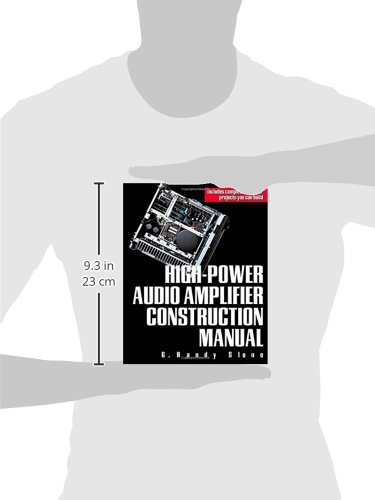



High-Power Audio Amplifier Construction Manual
R**S
This is the one!
I've been thinking about putting my 30+ years in electronics to use and build something worthwile. In the late '80s I bought a Nakamichi PA300 for my car and nothing has come close to it. I've since recapped it and it still jams. In an effort to complement it I started looking through what today's tech has to offer. A class D with literally 100 times more distortion is about all that you can find nowadays unless you spend about 100 times more money than I did back in the '80s.Anyway I got this book (and several others) to explore the possibility of building something comparable to my Nakamichi. This book uses the writings of Self and others to come up with several feasible designs of varying power and quality. He puts it in perspective for you and points out what decisions you'll need to make first (power source and output, topology, BJT or FET, etc.). But first you need 3 things that will dictate what you do more than anything, the right power supply, the right heatsink, and this book.
A**E
Awesome Book!!!
I have been studying amplifer circuits for some time but always left wondering why certain components were needed. This book explains the advantages and disadvantages of many amplifier designs as well as the "why', without using two pages of calculus to explain it. I haven't built an amp yet, but I'm confident that the one I build will be excellent using the knowledge I've gained from reading this book.
J**.
The book has a ton of great information and schematics
This is a very technical book. Don't buy this unless you have a developed understanding of electronics. If it were not for that or if it were simply had the word advanced in the title I would have given it 4 stars. The book has a ton of great information and schematics. Has a few PCB layouts as well and several amp design projects.
A**E
Nice addition to my library
This book was a nice purchase, I thought it would only cover construction of high power amplifiers, I was surprised to find out theres quite a bit of theory in there aswell. It is evident that the author uses as foundation the books and articles by Self and Cordell since many of the designs are based on those by the before mentioned authors. The book features several circuits and PCBs so the reader can build his own power amplifiers, however the big disadvantage with Mr. Slone's books is that the PCB masks are printed in the book rather than offered in a CD or similar media, so in order for you to properly use the PCB masks, you have to either torn the page apart from the book or you have to force open the book to the point in which you break or damage the spine in order to take a proper scan or photocopy.
A**R
Very detailed.
Very detailed step-by-step presentation with many helpful examples and schematics to re-enforce the presentation.A great book that doesn't assume the readers prior knowledge of the subject material.
R**N
Solid State Audio Amplifiers
Randy Slone writes a no nonsense discussion of the vacuum tube vs solid state controversy. He presents the rationale behind the designs presented in this book. It is fascinating reading.This book has brought me up to date with the current state of the art in the field of solid state audio amplifiers. It got me started experimenting with simple audio circuits again, and has inspired me to build one of the designs in the book.It was well worth the price!
R**R
Some of the circuits simply will not work.
This review is based on the first edition. I do not know whether there are any later editions.The introduction material is rather derivative of authors like Douglas Self.However some of the circuits are seriously flawed and simply will not work because the author simply does not understand some basic concepts. For example, the quiescent biasing is undefined and arbitrary in some instances. (This was pointed out to the author several years ago.) For example in figures 10.2, 10.3, 11.10, 11.12, 11.13, 11.14, 12.1 all have the same error; the current through the VAS stage may be anything, so the stage may be biased off, in which case the amplifier will oscillate, or biased on in which case the stage will suffer thermal run-away.In addition some of the quoted distortion figures are clearly wrong and seem to be based on a spice or similar program output rather than real measurements, which will give quite different values owing to real voltage drops across PCB tracks and non-linear magnetic field feedback etc.
T**C
Nice book
Nice addition to my electronics books library. I bought mine used. It arrived fast and in good condition.
Z**O
ben fatto
ottimo libro, ben redatto e completo. Consiglio a tutti gli audiofili.ottima guida per costruire amplificatori a componenti discreti o transistorVi sono anche degli esempi completi di progetto
I**S
Good choice!
Comparing with Self's books, I think this one is better, covering every detail in Amps design.From PS to output, all subjects are discussed clearly.
L**R
ENtre pratique et théorie
Apporte quelques points par rapport à l'ouvrage de Self mais ne peut se suffir à lui même. Il a une approche moins exhaustive des circuits, le coté théorique est un peu négligé ou simplifié. Le coté pratique avec la réalisation de certains amplificateurs peut être intéressant, mais il faut savoir aller plus loin que ce qui est écrit pour faire la mise au point et achever le circuit.
A**R
Five Stars
Fantastic resource, although not for absolute beginners. A background in electronics is advisable.
D**E
Five Stars
Great
Trustpilot
1 month ago
1 week ago